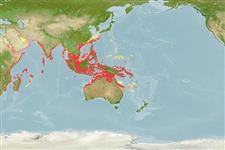>
Eupercaria/misc (Various families in series Eupercaria) >
Lutjanidae (Snappers) > Lutjaninae
Etymology: Lutjanus: Malay, ikan lutjan, name of a fish.
More on author: Bloch.
Environment: milieu / climate zone / depth range / distribution range
Ecologia
marinhas associadas(os) a recifes; intervalo de profundidade 0 - 96 m (Ref. 57178). Tropical; 32°N - 26°S, 31°E - 165°E (Ref. 55)
Indo-West Pacific: East Africa to the Solomon Islands, north to southern Japan, south to Australia. Recently recorded from Tonga (Ref. 53797). Usually referred to as Lutjanus lineolatus by previous authors.
Comprimento de primeira maturação / Tamanho / Peso / Idade
Maturity: Lm 12.2, range 11 - 24.6 cm
Max length : 35.0 cm TL macho/indeterminado; (Ref. 5450); idade máx. registrada: 11 anos (Ref. 55)
Espinhos dorsais (total) : 10 - 12; Raios dorsais (total) : 12; Espinhos anais: 3; Raios anais : 8. Dorsal profile of head gently sloped. Preorbital bone very narrow, much less than eye diameter. Preopercular notch and knob poorly developed. Scale rows on back rising obliquely above lateral line. Generally silvery white, with a broad yellow stripe running along the side from the eye to the caudal fin base. A series of faint narrow yellow horizontal lines is on the lower half of the body. The fins are pale yellow to whitish (Ref. 469). Body depth 2.9-3.3 in SL (Ref. 90102).
Adults inhabit offshore coral reefs and trawling grounds. Trawled to depth of almost 100 m (Ref. 48635). Frequently encountered in large schools with other Lutjanus species (Ref. 9710). Feed on fishes and crustaceans (Ref. 30573).
Allen, G.R., 1985. FAO Species Catalogue. Vol. 6. Snappers of the world. An annotated and illustrated catalogue of lutjanid species known to date. FAO Fish. Synop. 125(6):208 p. Rome: FAO. (Ref. 55)
Status na Lista Vermelha da UICN (Ref. 130435)
Ameaça para os humanos
Harmless
Uso pelos humanos
Pescarias: altamente comercial
Ferramentas
Relatórios especiais
Baixar XML
Fontes da internet
Estimates based on models
Preferred temperature (Ref.
123201): 24.9 - 29.1, mean 28.1 °C (based on 1914 cells).
Índice de diversidade filogenética (Ref.
82804): PD
50 = 0.5000 [Uniqueness, from 0.5 = low to 2.0 = high].
Bayesian length-weight: a=0.01622 (0.01061 - 0.02479), b=2.95 (2.83 - 3.07), in cm total length, based on LWR estimates for this species & Genus-body shape (Ref.
93245).
Nível Trófico (Ref.
69278): 4.1 ±0.62 se; based on food items.
Resiliência (Ref.
120179): médio(a), tempo mínimo de duplicação da população 1,4 - 4,4 anos (K=0.5; tmax=11).
Fishing Vulnerability (Ref.
59153): Low to moderate vulnerability (25 of 100).
Nutrients (Ref.
124155): Calcium = 43.5 [28.8, 60.1] mg/100g; Iron = 0.375 [0.238, 0.560] mg/100g; Protein = 18.6 [17.1, 19.9] %; Omega3 = 0.153 [0.109, 0.211] g/100g; Selenium = 63.6 [42.8, 92.8] μg/100g; VitaminA = 145 [28, 534] μg/100g; Zinc = 0.451 [0.360, 0.629] mg/100g (wet weight); based on
nutrient studies.
